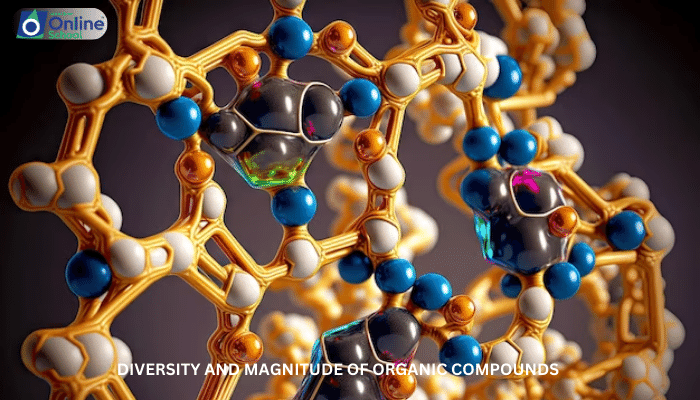
Learning Outcomes:
i. Explain the factors that contribute to the vast diversity of organic compounds.
ii. Analyze the role of carbon's unique bonding properties in forming a vast array of organic molecules.
iii. Recognize the concept of isomerism and its implications for the existence of multiple organic compounds with the same molecular formula.
iv. Appreciate the immense number and diverse structures of organic compounds due to carbon's catenation and tetrahedral bonding.
v. Explore the significance of functional groups in distinguishing and classifying organic compounds.
Introduction
Organic chemistry is a realm of immense diversity, encompassing an astonishing array of compounds that span the gamut from simple hydrocarbons to complex biomolecules. This remarkable diversity stems from carbon's unique bonding properties and its ability to form stable chains and rings of various sizes. In this lesson, we will delve into the factors that contribute to the vast magnitude of organic compounds, unraveling the secrets behind carbon's versatility and the intricate world of organic molecules.
i. The Versatility of Carbon Bonding
Carbon's remarkable bonding properties are the driving force behind the vast diversity of organic compounds. Carbon can form covalent bonds with a variety of atoms, including hydrogen, oxygen, nitrogen, and sulfur. These bonds can be single, double, or triple, leading to a myriad of structural possibilities.
ii. Catenation: The Chain-Forming Ability of Carbon
A unique property of carbon is its ability to catenate, meaning it can form strong bonds with other carbon atoms to create chains and rings of various lengths. This catenation ability, coupled with carbon's tetrahedral bonding, allows for the formation of an almost limitless number of carbon skeletons, the backbone of organic molecules.
iii. Isomerism: Multiple Compounds with the Same Molecular Formula
Isomerism, a fascinating phenomenon in organic chemistry, arises from the existence of multiple compounds with the same molecular formula but different structural arrangements. This occurs due to the different ways in which carbon atoms and functional groups can be arranged in space.
Structural Isomers: Structural isomers have the same atoms but differ in the arrangement of those atoms. For instance, ethane (CH3CH3) and propane (CH3CH2CH3) are structural isomers.
Stereoisomers: Stereoisomers have the same atoms and the same connectivity but differ in the spatial arrangement of their atoms. An example is cis- and trans-2-butene, which have the same molecular formula (C4H8) but different spatial arrangements of their double bond.
iv. Functional Groups: The Distinguishing Features of Organic Compounds
Functional groups, specific arrangements of atoms within an organic molecule, play a crucial role in determining the properties and reactivity of organic compounds. By identifying and understanding functional groups, chemists can classify and predict the behavior of organic molecules.
Common Functional Groups: Some common functional groups include alcohols (-OH), aldehydes (-CHO), ketones (-C=O), carboxylic acids (-COOH), and amines (-NH2).
The vast diversity and magnitude of organic compounds stem from carbon's unique bonding properties, its ability to catenate, and the concept of isomerism. Functional groups further distinguish and classify organic molecules. Understanding these factors provides a foundation for exploring the intricate world of organic chemistry and appreciating its profound impact on various fields.